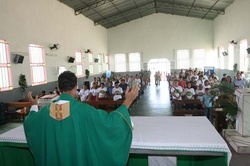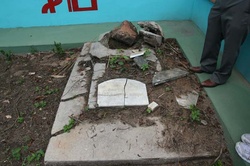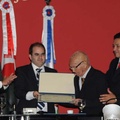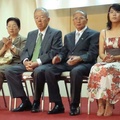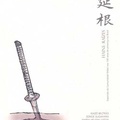As comemorações do 80º Aniversário
As comemorações foram organizadas pelas seguintes entidades: Associação Koutaku do Pará, sediada em Belém e presidida por José Shigueyoshi Ono; Associação Nipo-Brasileira de Parintins presidida por Mario Barroso Taketomi e Associação Koutaku do Amazonas, sediada em Manaus e presidida por Valdir Hiçashi Sato.

Valdir Sato, presidente da Associação Koutaku do Amazonas, no momento do corte do bolo, observado pelo deputado Tony Medeiros (Manaus)
Sobre as festividades, Antão Ikegami, representante em São Paulo da Associação Koutaku do Amazonas, relata que foram realizadas no dia 21 de outubro em Belém; depois em Parintins, em 23 de outubro e, finalmente, em Manaus, no dia 25 de outubro. Um detalhe curioso, aponta, “nas três localidades, o primeiro ato da comemoração foi a celebração de uma missa católica, o que revela o nível de inserção dos Koutakuseis aos costumes locais”.
Além disso, ressalta Ikegami, “dos 243 graduados que vieram nas sete levas, devido às dificuldades de adaptação à nova terra e à dispersão imposta pela Segunda Guerra, atualmente, menos da metade dessas famílias reside na região Norte do país, grande parte delas vive na região sul”.
Para a comemoração dos 80 anos, a Associação Nipo-Brasileira de Parintins tinha programada a reconstrução do Hakko Kaikan (um centro sociocultural em forma de templo, construído em comemoração aos 2.600 anos de constituição do Japão e 10º aniversário de fundação da Vila Amazônia) e do Memorial dos Koutakuseis. A maior parte dos recursos seria doada pelo governo japonês e, diante do terremoto e tsunami ocorridos no dia 11 de março, mesmo com a garantia de que se “honraria o prometido”, a entidade resolveu suspender os planos para uma “oportunidade mais propícia”.
Assim, a comemoração foi marcada pela recuperação do cemitério japonês de Vila Amazônia, onde foram sepultadas pelo menos 15 pessoas.
Dias depois, em Manaus (localizada a 7 ou 8 horas em lancha rápida e cerca de 18 horas em barco normal de Parintins), aconteceu o ponto alto das festividades, liderada pela Associação Koutaku do Amazonas. Na manhã do dia 25 de outubro, o evento começou com uma missa na Igreja Nossa Senhora de Nazaré (local de peregrinação dos católicos da região) celebrada pelo arcebispo de Manaus, Dom Luiz Soares Vieira.
“Os descendentes e seus familiares, como a comunidade local e os convidados, assistiram emocionados às palavras do arcebispo no momento da homilia”, informou Antão Ikegami. No pronunciamento, disse que, “além dos resultados econômicos, os Koutakuseis deixaram exemplos de trabalho, honestidade, paciência e perseverança” e pediu aos seus descendentes que não deixassem “desaparecer essa história cheia de trabalho, respeito e sempre recheado de muita esperança”.
Em seguida, às 10h, teve início a Sessão Especial “Kizuna no Hi” (Dia do Laço), alusiva aos 80 Anos da Imigração Koutakusei no Amazonas, ocasião em que, “finalmente conseguimos realizar duas coisas que era da maior importância aos nossos pais: o reconhecimento do trabalho deles para o desenvolvimento do Amazonas e o pedido de desculpas oficiais pelo tratamento injusto a que foram submetidos durante a Segunda Guerra Mundial”, afirmou Valdir Hiçashi Sato, presidente da Associação Koutaku do Amazonas.
Nessa sessão foi promulgada a lei 99, de 20 de outubro, de autoria do deputado Tony Medeiros, que determina o dia 21 de outubro de 1930 “como data histórica comemorativa da colonização agrária dos Koutakuseis precursora do Ciclo Econômico da Juta no Amazonas”.
No artigo 2º, a lei determina que: “fica reconhecido o Ciclo da Juta como ciclo de desenvolvimento econômico do Estado do Amazonas, tornando obrigatória a utilização de obras regionais em seu estudo no currículo escolar dos cursos integrantes do Sistema Estadual de Ensino”.
Assim, comenta Antão Ikegami, “ao término do Ciclo da Borracha e antes da implantação da Zona Franca, as escolas vão ensinar sobre o Ciclo da Juta, introduzida e desenvolvida pelos imigrantes japoneses, especialmente pelos Koutakuseis”.
O 3º artigo da lei 99 traz uma decisão inédita e “pela primeira vez um executivo nacional faz um pedido oficial aos imigrantes japoneses”, exalta Antão Ikegami, admitindo que, “antes da comemoração, muito se comentou sobre essa possibilidade, mas ninguém achava que essa lei seria promulgada”.
A íntegra desse artigo diz: “Em preito de perene gratidão, esta lei consigna o pedido formal de desculpas aos briosos Koutakuseis e seus descendentes, pelos excessos aos quais foram injustamente submetidos durante a 2ª Guerra Mundial, enquanto trabalhavam pelo Brasil em solo amazonense”.
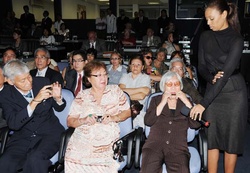
Junto com as palavras de agradecimentos de Shoji, o Hino dos Koutakuseis interpretado por Sumiko Ihara (Manaus)
Durante a sessão solene na Assembleia também foram outorgados os títulos de Cidadão do Amazonas aos koutakuseis remanescentes: Mamoru Chiba e Zennonshin Shoji (veja a biografia deles publicada no livro “A Saga dos Koutakuseis no Amazonas”). Além deles, foram homenageadas as viúvas de koutakuseis: Sumiko Ihara, Mie Hagi e Fumiko Miwa.
Ikegami ainda lembra que a senhora Sumiko Ihara se encarregou de quebrar o protocolo e emocionar a todos os presentes. No momento das palavras de agradecimentos do novo cidadão do Amazonas, Zennonshin Shoji, ela começou a tocar em sua gaita o Hino dos Koutakuseis.
A comemoração dos 80 Anos do Koutakuseis no Amazonas foi encerrada às 19h30, com jantar no salão da Associação Nippaku, do Amazonas, para cerca de 200 convidados (e cerca de 10 pessoas do Japão, da Europa e de outros estados brasileiros). Além das homenagens e agradecimentos (principalmente ao deputado Tony Medeiros, autor da lei 99), foi exibido um documentário sobre o Projeto dos Koutakuseis.
* Esse artigo foi originalmente publicado no Bunkyo website em 29 de Novembro de 2011.
© 2011 Célia Abe Oi


